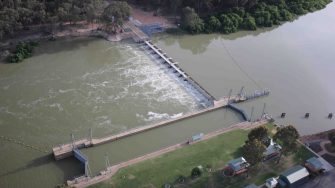
Date: Thursday, November 6, 2014
Project: Eastern Australian Waterbird Survey
Observer: Richard Kingsford
We arrived at the airport by six for a quick breakfast and away before the heat hit us. Today, we flew a long section of the River Murray, from Wentworth in NSW to Berri in South Australia. It covers the mouthful of a wetland – the Chowilla floodplain- Lindsay-Walpolla Islands. This is a wetland of international significance.
Photo 1. The River Murray has a large main channels, flanked by river red gums on the floodplain
The relatively small channelled Darling River comes in from the northeast, to meet the larger channelled River Murray from the southeast, at the town of Wentworth, the site of Lock 10. Sometimes you can see the differences in the colour of the water, particularly after flood when the Darling delivers its brown water to mix with the River Murray. Not today. They were indiscernible.
The Darling River meets the River Murray at the NSW town of Wentworth, the site of Lock 10.
There are 13 Locks on the River Murray, numbered one to 11, 15 and 26, reflecting the historical plans to build many more after the River Murray Commission was established in 1917. These are a historical feature established to maintain the River Murray as a transport route for steamers and barges that carried wool and produce in the 19th century up the river. We flew over the locks but to get through in your boat, you have to avoid lunch times and ask to get through with “three prolonged blasts (4 seconds each) on a whistle, air or electric horn or other suitable device (i.e. mobile phone)”. These locks have now changed the ecology of the river from one that is now more similar to lakes.
Photo 2. One of the upper locks on the River Murray.
We followed the River as it meandered its way past Lake Victoria and then onto the often parched Chowilla floodplains. These are often white, reflecting the built up salt and there are plenty of dead river red gums in this part of the river. It is a strong contrast to the upper part of the river. Water is now being managed into some of the wetlands where there sometimes hundreds of waterbirds.
One of the lakes on the Chowilla floodplain with hundreds of waterbirds
The river is wide and dotted with house boats and lazy pelicans floating by. We counted waterbirds in the ones and twos along the river and always the fish-eating birds, seldom the ducks or wading birds. They could be guaranteed on the lakes filled by the river.
We left the river at Berri and flew south, intercepting some Salt disposal ponds at Stockyard Plain Basin. This is where highly saline water is diverted from the salt mitigation works in the Riverland of South Australia. Once large floods used to flush the salt out down the river and out to sea. This no longer happens. This artificial wetland is guaranteed to grow as there is more salt water predicted in the future. It is a great place for swans and some of the duck species. The salt clears the water allowing aquatic plants to grow – good for swans- and also there are often large numbers of crustaceans for the ducks, like pink-eared duck.
Photo 3. The salt disposal ponds at Stockyard Basin – a good wetland for swans and some ducks
Eventually we made it to one of Australia’s and the world’s most important wetland systems – the Coorong, Lower Lakes and Murray Mouth. This internationally important wetland is going to take us two days to survey. It is massive and the waterbirds are incredible. Particularly at the moment because there is hardly any other water around.
Photo 4. The northern edge of Lake Alexandrina with its reedbeds.
We surveyed Lakes Alexandrina and Lake Albert – the two freshwater lakes. They are kept fresh by barrages established in the mid 1930s, primarily because the lakes were not as fresh as they used to be with the increasing extraction of water upstream by New South Wales and Victoria. Decades on and the amount of fresh water extracted upstream is so much that the mighty River Murray which was once able to keep the sea at bay most of the time, cannot any longer do this with the amount of fresh water that comes down the river.
ABC Radio covered the aerial survey story on it's PM program this afternoon.
There were astounding numbers of waterbirds of many different species. We were flat out counting for a full hour and half as we went around the lake. There were thousands of pelicans, cormorants, swans and Australian shelduck. And in among all of these I saw a dark shape in Lake Alexandrina, just the lake side of the barrages. It took me a while to work out it was a seal, probably a New Zealand fur seal. They used to go quite far up the river.
Hundreds of cormorants and pelicans roost on the edge of the lake and fly off when we survey, allowing us to count them.
As if to underline how healthy this ecosystem is, there were many waterbirds breeding including swans, pied cormorants, straw-necked ibis, spoonbills and white ibis. We hadn’t seen any breeding in our month or so of surveys that even came close to this.
Photo 5. Breeding colony of straw-necked ibis and pied cormorants on Lake Alexandrina
Tomorrow the Coorong. I can't wait.
